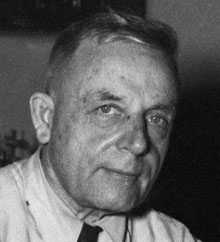Otto Heinrich Warburg


- Year of birth: 1883

- Year of death: 1970

- Wikipedia
BIOGRAPHY
Otto Heinrich Warburg - 8 October 1883 - 1 August 1970) was a German physiologist, medical doctor, and Nobel laureate. Born in Freiburg im Breisgau in 1883, Warburg studied chemistry under Emil Fischer and got his doctorate in chemistry in Berlin in 1906. He then studied under Ludolf von Krehl and obtained the doctorate in medicine in Heidelberg in 1911. Between 1908 and 1914, Warburg conducted researches at the Naples Marine Biological Station. In later years, he would regularly return for visits, and maintained a lifelong friendship with the family of the station's director, Anton Dohrn. In 1918, Warburg was appointed professor at the Kaiser Wilhelm Institute for Biology in Berlin-Dahlem (an Institute of the Kaiser-Wilhelm-Gesellschaft). In 1931 he was named director of the Kaiser Wilhelm Institute for Cell Physiology, which had been founded the previous year by a donation of the Rockefeller Foundation.
In 1931 Warburg was awarded the Nobel Prize in Physiology for his "discovery of the nature and mode of action of the respiratory enzyme". In particular, he discovered that animal tumours produce large quantities of lactic acid.[6] The award came after receiving 46 nominations over a period of nine years beginning in 1923.
After the Nazis took power, Warburg, who had a Protestant mother and a father with Jewish heritage, was considered a ‘half-Jew'. He was banned from teaching, but he was allowed to carry on his research on cancer metabolism, probably because Hitler was obsessed with cancer, having lost his own mother for a breast cancer at an early age.
Warburg pursued his research until the age of 86 and resided in the Kaiser Wilhelm Institute with his companion of 50 years, Jacob Heiss, the secretary and manager of the Kaiser Wilhelm Institute.
In 1968, he suffered a broken femur, complicated by deep vein thrombosis. He died in 1970 from pulmonary embolism and was buried in the Christian Berlin-Dahlem cemetery.

